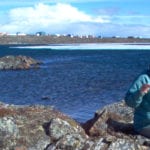In my previous post, I introduced the special issue of the Canadian Journal of Earth Sciences(CJES) that celebrates the 30th anniversary of the Royal Tyrrell Museum of Palaeontology (RTMP). In this post, I want to delve into a bit more detail about how the RTMP and the community it supports have contributed to significant advances in paleontology.
One of the papers in the issue — made freely available to the public via open access — centres on the study of bonebeds. As their name suggests, these are areas where a large number of fossilized bones are found close together. They are quite common in Alberta; in fact you don’t even have to leave the city limits of Edmonton to find one.
But the thing about bonebeds is that instead of being nicely laid out as they were in the living animal — the paleontology term is ‘articulated’ — bones from bonebeds are all jumbled up. For this reason, they have been overlooked. “They were ignored by many collectors during the past 100 years in preference of specimens with articulated skulls and skeletons—so called ‘trophy specimens’,” says Dave Eberth, Research Scientist at the RTMP and co-author of the paper.
Eberth says that today, bonebeds are undergoing something of a rehabilitation. There is greater recognition of the fact that a large number of bones from the same species can tell you things a single skeleton never could. “At these sites we can document how the skeletons of these animals changed as they grew, their growth rates, and what factors influenced their lives, growth and death,” he says. But in order to excavate them, you need a lot of manpower. And that’s something the RTMP has in spades.
From 1993 until 2004, the museum operated a program called Day Digs. Visitors — anybody aged 10 or older — could take a bus from the RTMP to a nearby bonebed. There they would spend the day helping paleontologists map out exactly where the bones were on a grid of the site. They would also help excavate a few carefully selected samples to be taken back to the museum.
Eberth describes the data-collection process as “semi-rigorous” because of the large numbers of people and their wide range of ages, background and abilities. Nevertheless, over the course of ten years, a small army of volunteers mapped and catalogued thousands of specimens from three bonebeds: Bleriot Ferry, Fox Coulee and Prehistoric Park. All of these were dominated by a single kind of dinosaur: Edmontosarus regalis, a large duck-billed creature that lived in the area, back when it was a fertile coastal plain.
The results showed that at two of the three sites, the remains were almost entirely from adult dinosaurs. Combined with previous work, this supports the idea that although Edmontosaurus lived in herds, the adults and juveniles may have travelled in separate groups. In this way, they could avoid competing for the same resources and gain a better chance of survival.
Bonebeds dominated by a single type of animal are rare compared to those filled with many different species. The former, called monotaxic bonebeds, usually form when many animals die at the same place and time. At the time the Edmontosaurus lived, southern Alberta was prone to coastal floods; this may have been what killed and eventually buried these dinosaurs. However, in between death and burial, there must have been a period where the carcasses were exposed. Some of the bones showed evidence of tooth and claw marks, and the volunteers even found teeth from the large predator Albertosaurus, a cousin of Tyrannosaurus rex. In other words, the bodies were scavenged before they were fossilized.
Eberth says that there is much more to be gleaned from bonebeds like these. For example, many modern analysis techniques — such as those that involve analysing the chemical elements or isotopes in a fossil — require at least partial destruction of the sample. That’s a hard proposition when you only have one skeleton in all the world, but in a bonebed there is lots of material to spare.
There is also the fact that assemblages of lots of bones tell you a lot about all the different animals that lived together, and how they interacted. “Today, we realize that bonebeds yield some of the most robust paleobiological and paleoecological information available about dinosaurs, and thus are well worth the trouble to work,” says Eberth. That may mean more large-scale projects like Day Digs in the future, and more budding paleontologists getting their first taste of fieldwork.




